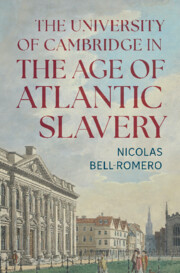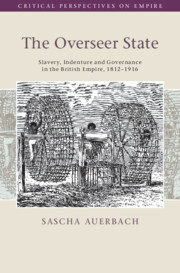Refine search
Actions for selected content:
383 results
1 - ‘The principal ingredient necessary to form a good planter’: Education and the Making of a Transatlantic Elite
-
- Book:
- The University of Cambridge in the Age of Atlantic Slavery
- Published online:
- 12 September 2025
- Print publication:
- 30 October 2025, pp 19-48
-
- Chapter
-
- You have access
- Open access
- HTML
- Export citation
Introduction
-
- Book:
- The University of Cambridge in the Age of Atlantic Slavery
- Published online:
- 12 September 2025
- Print publication:
- 30 October 2025, pp 1-18
-
- Chapter
-
- You have access
- Open access
- HTML
- Export citation
For their Own Ends: Universalist Idealism and Political Pragmatism in Late Colonial Human Rights Reforms
-
- Journal:
- Itinerario , First View
- Published online by Cambridge University Press:
- 26 September 2025, pp. 1-17
-
- Article
-
- You have access
- Open access
- HTML
- Export citation

The University of Cambridge in the Age of Atlantic Slavery
-
- Published online:
- 12 September 2025
- Print publication:
- 30 October 2025
-
- Book
-
- You have access
- Open access
- Export citation
Aldborough and the metals economy of northern England, c. AD 345–1700: a new post-Roman narrative
-
- Journal:
- Antiquity , First View
- Published online by Cambridge University Press:
- 11 September 2025, pp. 1-21
-
- Article
-
- You have access
- Open access
- HTML
- Export citation
Chapter 5 - Tunnel
-
- Book:
- Railway Infrastructure and the Victorian Novel
- Published online:
- 12 August 2025
- Print publication:
- 28 August 2025, pp 119-149
-
- Chapter
- Export citation
‘Beastial Communications’: Race, Friendship and Factionalism in the Madras Army, 1832–1837
-
- Journal:
- Transactions of the Royal Historical Society , First View
- Published online by Cambridge University Press:
- 06 August 2025, pp. 1-26
-
- Article
-
- You have access
- Open access
- HTML
- Export citation
50 - Barbarians and Migrations
- from Part V - Issues and Debates
-
- Book:
- The Cambridge Encyclopaedia of Late Antique Art and Archaeology
- Published online:
- 04 July 2025
- Print publication:
- 31 July 2025, pp 888-901
-
- Chapter
- Export citation
The Plague of Provence (1720–2) and debates in Britain on the cross-species transmission of disease
-
- Journal:
- Medical History , First View
- Published online by Cambridge University Press:
- 14 July 2025, pp. 1-18
-
- Article
-
- You have access
- Open access
- HTML
- Export citation
Stavert, Zigomala & Co.: A Transnational History of the Anglo-Cuban Textile Trade During 1860s–1914
-
- Journal:
- Enterprise & Society , First View
- Published online by Cambridge University Press:
- 14 July 2025, pp. 1-46
-
- Article
-
- You have access
- Open access
- HTML
- Export citation

Insularity and Identity
- Prehistoric Britain and the Archaeology of Europe
-
- Published online:
- 05 May 2025
- Print publication:
- 29 May 2025
-
- Element
- Export citation
6 - Cementing Nationalisation (1918–1925)
-
- Book:
- The European Art Market and the First World War
- Published online:
- 10 April 2025
- Print publication:
- 17 April 2025, pp 204-232
-
- Chapter
- Export citation
2 - The Great Conflagration (1914–1918)
-
- Book:
- The European Art Market and the First World War
- Published online:
- 10 April 2025
- Print publication:
- 17 April 2025, pp 66-104
-
- Chapter
- Export citation
The politics of early Neolithic connectivity: Relations between Britain and Ireland
-
- Journal:
- Proceedings of the Prehistoric Society , First View
- Published online by Cambridge University Press:
- 15 April 2025, pp. 1-15
-
- Article
-
- You have access
- Open access
- HTML
- Export citation

The Overseer State
- Slavery, Indenture and Governance in the British Empire, 1812–1916
-
- Published online:
- 21 March 2025
- Print publication:
- 27 March 2025
3 - The Rise and Fall of the United Kingdom’s Forgotten Utility Model
- from Part I - Utility Model Laws and Practices around the World
-
-
- Book:
- Sub-patent Innovation Rights
- Published online:
- 06 February 2025
- Print publication:
- 13 February 2025, pp 31-85
-
- Chapter
-
- You have access
- Open access
- HTML
- Export citation
2 - The Pattern of Later Iron Age Societies
-
- Book:
- The Romanization of Britain
- Published online:
- 02 January 2025
- Print publication:
- 16 January 2025, pp 9-39
-
- Chapter
- Export citation
The 1943 West African Editors’ Press Delegation to the United Kingdom: Mediating the Metropole from World War II Nigeria
-
- Journal:
- Itinerario / Volume 49 / Issue 1 / April 2025
- Published online by Cambridge University Press:
- 14 January 2025, pp. 156-175
-
- Article
-
- You have access
- Open access
- HTML
- Export citation
11 - Dealing with the Dead in the China-Burma-India Theater
- from Part IV - The New Imperialism
-
-
- Book:
- Uneasy Allies
- Published online:
- 12 December 2024
- Print publication:
- 19 December 2024, pp 194-214
-
- Chapter
- Export citation
18 - Rights and Empires
- from Part III - Rights and Empires
-
-
- Book:
- The Cambridge History of Rights
- Published online:
- 22 January 2025
- Print publication:
- 28 November 2024, pp 437-462
-
- Chapter
- Export citation
